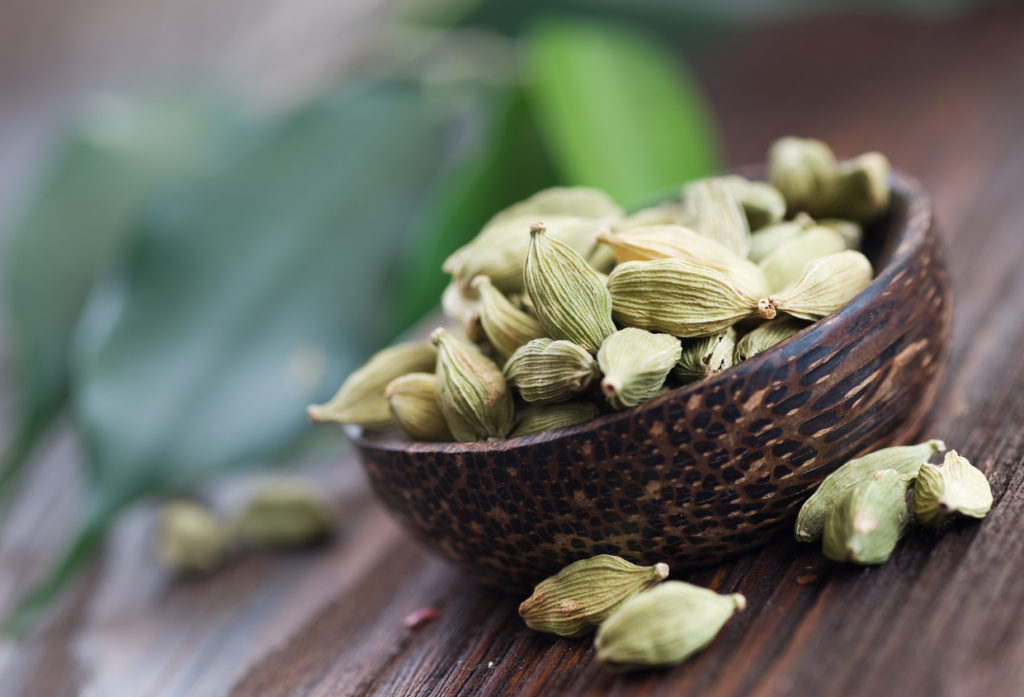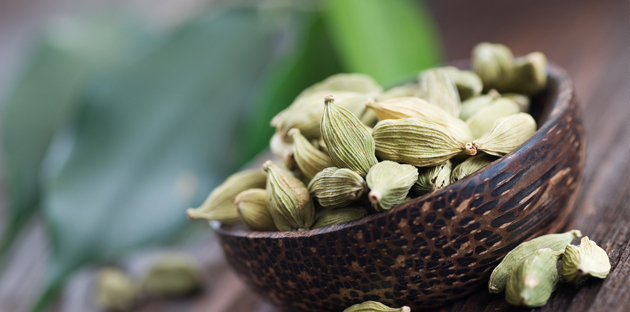For over 3,000 years, the fragrant seed pods of a tropical plant known as Cardamom have been cherished throughout the Eastern World. This exotic spice has been used in perfumery, sacred incense blends, ointments, medicine, and cuisine since before the construction of Solomon’s Temple. Cardamom is a plant native to India.
It can be found growing in its natural habitat on the woody slopes in the humid forests of the Himalayas and in other parts of India. Today, it is cultivated around the world in warmer zones and can be found at most grocery stores as a sweet, pungent culinary herb.
I find that Cardamom incense or essential oil is very ideal for the colder months as our diets reflect the growing seasons, and when we simply don’t get outdoors as much. Ingesting larger amounts of fats, bone broths, roots vegetables, and dense foods in general in the Fall and Winter months, while people are in more of a state of hibernation indoors, certainly leads to more sitting, lounging, and less exercise and movement in general.
Cardamom has the power to motivate and encourage me to get up and get out. It stimulates the mind and the energies of the body, while uplifting the spirit and helping me to feel the warmth and vibrance of life when all of nature is cold, still, and silent.

Aside from its many digestive benefits and its wide use in cultural cuisines around the world, Cardamom has also been employed for sacred as well as medicinal purposes in the form of incense for ages. Incense tends to be a very overlooked art form in the Western world, but for thousands of years, the medicinal application of plant smoke has been widely used in Traditional Chinese medicine, Egyptian medicine, Tibetan medicine, Ayurveda, and many other ancient medical practices to treat a variety of physical, mental, emotional, and spiritual imbalances.
Cardamom is known for its unique balance of pungent, sweet, and camphoraceous aromas. It was prized by ancient Egyptians and Romans who used it in many sacred anointing oils, ritual incenses, perfumes, and cosmetic ointments. In addition to its use as incense, it is also said to be one of the oldest known oils used in ancient aromatherapy.
Cardamom is traditionally used in many forms as a general tonic for vitality, stability, and overall physical and mental balance. This potent aromatic medicine has the ability to bring vibrancy to one's life by boosting energy and defeating sluggishness. It is a perfect herb to use as incense, in your favorite chai recipe, or incorporated into your meals in the Fall and Winter months to help combat fatigue and stagnation.
For millennia, Cardamom has been an important herbal medicine in Ayurveda and Traditional Chinese medicine. As an incense or inhalant, this warming, uplifting expectorant is used to combat lung disease, nervous disorders, and many mental imbalances. In Ayurveda, the ancient Indian philosophy of healing and balance, Cardamom is indicated for opening and soothing the flow of the pranas in the body and for bringing clarity and stability to an over-thinking or cloudy mind. It is an ideal spice for Vata types. It is also known in the East as a “gentle” tonic for the nervous system.
Traditional Ayurvedic practitioners often prefer to use Black Cardamom, native to the Eastern Himalayas. The pods are dark brown and quite longer than the common green pod variety. Brown pods have a stronger camphoraceous and sweet aroma. The pods are dried over an open fire; which also gives them a slightly smoky fragrance and flavor. These are used as a warming and pungent remedies that help to remove Kapha energies from the lungs and as an overall rejuvenative, or “Rasayana,” remedy for Vata types.
Unlock Your Free Issue Of...
🌿 The Aromatic Medicine Garden Membership 🌿
Are you ready for a deeper, holistic dive into the world of aromatic plants? See what our membership is all about with your free sneak peek issue, including an hour-long plant talk and a 21-page plant monograph pdf.

In Traditional Chinese medicine, Cardamom is used in cases of stagnant Qi. It helps to fortify and bring strength to the Qi energy of the spleen-pancreas. Its camphoraceous aromas help to stimulate the Qi of the lungs, moving stagnant energy and releasing phlegm and congestion. Cardamom incense is also used as a tonic for the brain and nervous system. It helps to sharpen mental focus and concentration while helping people who feel sluggish find the desire for movement.
For those of us who are worried, stressed, or overburdened, Cardamom incense or essential oil can be a great solution when overwhelm starts to get the best of us. This potent seed holds the power to help me relax in the face of my challenges while strengthening my resolve to conquer them. Cardamom also helps to soothe anxiety and tension within the mind and nervous system. Its aromatic smoke has also been used to successfully treat certain types of headaches for many individuals.
The warm, spicy sweetness of Cardamom helps to release worry, anxiety, and over-thinking while promoting mental clarity and strengthening motivation, confidence, enthusiasm, determination, courage, and direction. Cardamom is also widely known for its potent aphrodisiac properties. This quality is beneficial to love partnerships but also ignites the flame of passion and love within oneself, helping one connect more deeply to their own emotional/energetic heart. It can also be used to heighten feelings of compassion and strengthen connection to the divine feminine.
Cardamom has been a precious and sacred incense spice for ages. Its aroma is sweet, warm, spicy, balsamic, camphoraceous, exotic, and slightly floral. Overall, Cardamom is calming to the nerves, uplifting to the spirit, stimulating to vitality, and clarifying to the mind. Its spiritual virtue is to encourage and stimulate one’s hunger for life.
Article by Evan Sylliaasen

Evan Sylliaasen is the founder of the Northwest School of Aromatic Medicine and Higher Mind Incense. For the past decade, his incense company has been a leader in sustainability and conscious sourcing of aromatic plants. As the head instructor of his online school, he teaches aromatherapists, incense lovers, herbalists, and spiritually-minded folks the traditional art of incense crafting, incense as medicine, and the art of wild-harvesting aromatic plants responsibly.
Evan lives with his family in the foothills of the Olympic Mountains of Washington state. He channels his creative passions through writing, photography, woodworking, craftsman building, and music. When he’s not working, he’s out in the garden, forest, and fields, walking along rivers, beaches, or in the mountains breathing deeply.
This article was recently published in Natural Herbal Living Magazine.
© 2017-2021 Evan Sylliaasen, The Northwest School of Aromatic Medicine. All Rights Reserved.
*The statements above have not been evaluated by the FDA. This article is not intended to diagnose, treat, cure, or prevent any disease.
